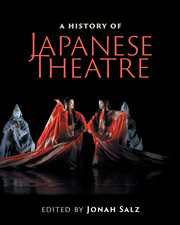Book contents
- Frontmatter
- Contents
- List of figures
- List of tables
- Contributors
- Contributors’ biographies
- Foreword
- Acknowledgments
- Note on Japanese terms
- List of abbreviations
- Timeline
- Editor's introduction
- I Traditional theatres
- Preface to Part I Japanese civilization arises
- II Modern theatres
- Preface to Part II
- III Arcs and patterns
- IV Theatre architecture
- Preface to Part IV Evolution of Japanese theatre architecture
- 16 Premodern patterns of spectatorship and space
- 17 Modernization of theatrical space, 1868–1940
- 18 Postwar theatres: development and diversifi cation
- Interlude National theatres and funding
- V Theatre criticism
- VI Intercultural influences
- Epilogue: Frozen words and mythology
- Further reading
- Index
- References
18 - Postwar theatres: development and diversifi cation
from Preface to Part IV Evolution of Japanese theatre architecture
Published online by Cambridge University Press: 05 July 2016
- Frontmatter
- Contents
- List of figures
- List of tables
- Contributors
- Contributors’ biographies
- Foreword
- Acknowledgments
- Note on Japanese terms
- List of abbreviations
- Timeline
- Editor's introduction
- I Traditional theatres
- Preface to Part I Japanese civilization arises
- II Modern theatres
- Preface to Part II
- III Arcs and patterns
- IV Theatre architecture
- Preface to Part IV Evolution of Japanese theatre architecture
- 16 Premodern patterns of spectatorship and space
- 17 Modernization of theatrical space, 1868–1940
- 18 Postwar theatres: development and diversifi cation
- Interlude National theatres and funding
- V Theatre criticism
- VI Intercultural influences
- Epilogue: Frozen words and mythology
- Further reading
- Index
- References
Summary
Theatre construction restarted with the needs of existing theatre activities shortly after the end of World War II, then expanded with postwar revival and economic growth. Highly diverse theatres were established, reflecting varied backgrounds: client, purpose, and technological innovation. The continuing pursuit of Western-style theatre that began in the Meiji period (1868–1912) can be observed in the process.
The revival of theatre by Shōchiku and Tōhō
With the war over, Japan's theatrical arts, chiefly kabuki, needed to recover their lost performance spaces. American bombs had destroyed or heavily damaged most of the big city theatres; postwar activities were limited to the few surviving theatres, such as Shōchiku's Tōkyō Gekijō (Tokyo Theatre, 1930), and Tōhō's Teikoku Gekijō (Imperial Theatre, 1911) and Nihon Gekijō (Japan Theatre, 1933), which raised their curtains soon after the end of the war.
War-damaged theatres either belonging to or affiliated with Shōchiku included Tokyo's Shinbashi Embujō (restored in 1948), Meiji-za (1950), and Kabuki-za (1951), Nagoya's Misono-za (1947), and Osaka's Naka-za (1948). Most Shōchiku and Tōhō theatres were relatively large due to their commercial use, independent buildings unattached to larger office or shopping complexes. Even the smallest could seat approximately 1,000 people, while the larger ones held over 3,000.
Theatres constructed by new private agents
From the 1950s onwards, a new kind of private theatre developed. These were constructed in urban centres by large enterprises with no direct connection to show business. Relatively early examples are Osaka's Sankei Hall (1952), constructed by a newspaper company, Tokyo's Daiichi Seimei Hall (1952), created by an insurance company, and Tokyo's Tōyoko Hall (1954), built by a department store.
These new theatres, created in accordance with modern administrative systems, differed somewhat from the commercial and artistic goals of Shōchiku and Tōhō venues. Often, they were not free-standing buildings but comprised a portion of their client's corporate office complex or department store, enhancing the companies’ images. When placed on an upper floor of a department store, as with the Tōyoko Hall, it was also presumed that a so-called “shower effect” would generate a trickle-down of customers to boost sales across the whole store. However, such theatres had limitations, being constructed according to the needs of the stores, which resulted in a lack of clear separation between audience and performers, narrow backstage areas, and technical difficulties in transporting stage sets.
- Type
- Chapter
- Information
- A History of Japanese Theatre , pp. 430 - 436Publisher: Cambridge University PressPrint publication year: 2016



